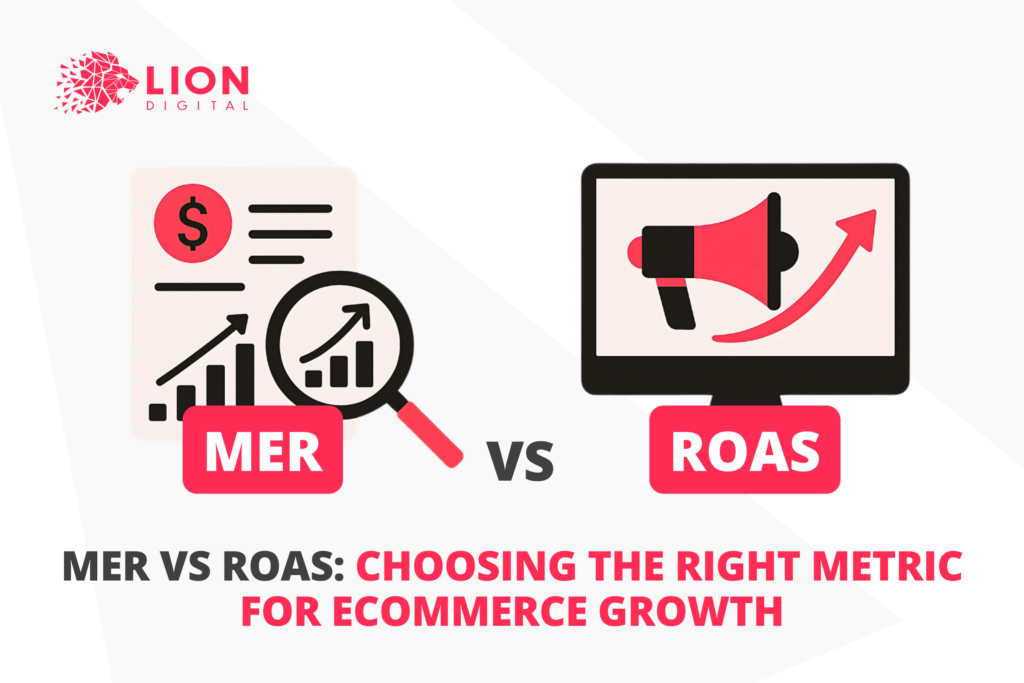
Digital marketing success for eCommerce relies on accurate measurement and optimisation of marketing initiatives. Marketers use a long list of metrics and calculations to track and drive marketing efficacy, although the main goal is always the same: driving revenue. At the same time, two metrics, ROAS and MER, have recently dominated strategic decision-making in measuring and optimising growth.
The Marketing Efficiency Ratio (MER) and Return on Ad Spend (ROAS) each offer a unique lens for evaluating marketing performance. These metrics help you measure the effectiveness of your advertising efforts and make smarter strategic and tactical decisions across channels. While they serve different purposes, MER and ROAS may seem similar, so it’s easy to get confused about which one to use. That’s why understanding when and how to apply each metric is essential in the path of driving growth.
This article will define MER and ROAS in marketing, consider their principal differences, and clarify when and why Marketing Efficiency Ratios vs Return on Ad Spend should be used.
What is MER (Marketing Efficiency Ratio) in marketing?
MER (Marketing Efficiency Ratio, sometimes called “Media Efficiency Ratio”) is the highest-level blended metric related to marketing performance, providing a holistic view across all channels. By definition, the primary meaning of MER in marketing is to express marketing efficiency on a business scale and not be limited to a separate marketing campaign scale. MER is a holistic metric for the overall strategy taken care of at the CMO level.
How to calculate MER?
MER metric evaluates overall marketing efficiency by comparing total revenue generated from all marketing efforts against the business’s total marketing expenses, including marketing costs. Therefore, the calculation of the Marketing Efficiency Ratio could be done by dividing the total revenue generated by marketing by the total spend on marketing channels involved in developing this revenue:
MER = TOTAL MARKETING REVENUE / TOTAL MARKETING SPEND
For instance, a business that invested $100,000 in all digital marketing channels, including but not limited to social media and email, generated a $500,000 return. The Marketing Efficiency Ratio is equal to five, or $5 for every dollar invested.
What is ROAS (Return on Ad Spend) in marketing?
ROAS is a lower-level granular metric that provides an overview of marketing efficiency on a channel, campaign, specific format, or whatever scale you prefer. The meaning of the ROAS for eCommerce marketing is highlighting short-term performance and profitability by demonstrating the immediate revenue generated for each dollar spent on a specific campaign or channel.
ROAS calculation for paid ads
ROAS (Return on Ad Spend) measures the revenue generated per dollar spent on a specific marketing unit. To calculate ROAS in marketing, simply divide the revenue generated by a single Paid channel or campaign by the total ad spend of the same channel or campaign:
ROAS = TOTAL AD CAMPAIGN REVENUE / TOTAL AD CAMPAIGN SPEND
For instance, a business that invested $20,000 in Ads on Amazon generated a $100,000 return. The Return On Ad Spend is five or $5 for every dollar invested.
Difference between ROAS vs MER
By now, the difference between MER and ROAS should be evident. To sum up:
| MER | ROAS | |
| Scale | Macro | Micro |
| Role | Strategy and profitability | Tactics and efficiency |
| Measures | Long-term results for all marketing | Short-term results per channel or campaign |
| Considers | All marketing expenses and revenue | Individual marketing channels, campaigns and their revenue |
| Determines | Overall marketing efficiency | Optimal advertising channel |
When to Use MER vs ROAS
The advantage of using MER is its simplicity in quickly assessing the financial health of marketing efforts. MER could be applied in decision-making when the marketing budget is tight; there is a need to highlight results for investors or evaluate choices applied throughout omnichannel campaigns, such as changing the messaging, launching an initiative to a new audience, rebranding, or expanding to a new market. MER may help you to understand whether the exact change made across all channels actually impacted the results on the business scale. MER is better when scaling brand, evaluating blended performance or working with hard-to-attribute channels such as social media influencers or email.
However, ROAS would help when you need to zoom in to determine what impact those changes made to separate channels and which channels reacted the best to the experiments. Thus, if you need to enhance campaign performance by uncovering trends and opportunities, optimising the budget allocation relying on concrete data, or achieving better results by focusing the resources on the best-performing campaigns, ROAS is your metric. It is indispensable when testing ad creatives, managing search engine marketing and social ad campaigns, and operating on a tight budget.
Developing proficiency in both metrics allows businesses to balance short-term marketing wins and long-term revenue increases. If you need help choosing the right metrics applicable to your business processes, LION’ seasoned eCommerce digital marketing consultants would guide you on this path.








